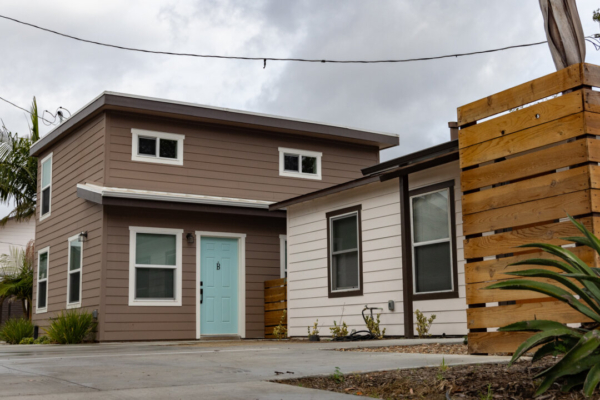In California, the construction volume of Accessory Dwelling Units (ADUs), also known as “Granny Flats/In-law units”, has increased significantly from just 1% of new building permits in 2016 to a remarkable 20% last year.
According to the latest data from the California Department of Finance, nearly 23,000 ADUs were constructed in California last year, leading to a 10% increase in new housing units in the state. Many homeowners find these units appealing as they can enhance property value, increase living space, or provide a retreat.
One homeowner in Los Angeles County, Sicola Elliott, transformed her garage into a two-bedroom ADU intending to rent it out to her children.
Elliott stated on EpochTV’s “California Insider” show, “The real estate market is so crazy, we are thinking where are they going to rent their first apartment, or even move out without falling into trouble? If you’re going to pay rent, pay it here.”
If the city where the property is located opts for California law, homeowners like Elliott can also sell their ADUs separately.
Since January 1st of this year, cities have the option to adopt Bill AB1033. The bill’s author, State Assemblyman Phil Ting, wrote in an analysis report that the bill allows homeowners to sell their “In-law units”, benefiting both sellers and buyers looking for affordable housing.
The Democratic state assemblyman from San Francisco pointed out the lack of housing opportunities in California, forcing working-class families to seek housing elsewhere.
After the passage of this new law, San Jose became the first city to participate in AB1033 and passed an ordinance effective in July.
ADU developer Dennis Robinson mentioned on the “California Insider” show that the new law has simplified the permitting process for ADU projects, allowing him to complete around 60 units in four years.
He noted that many people benefit from ADUs, and this construction trend is unlikely to dissipate soon.
According to Ting’s analysis, a state law passed in 2017 loosened restrictions on ADUs, sparking a surge in ADU construction. Ting also introduced another bill, AB68, to expedite local approvals and abolish parking requirements.
Robinson, who developed Elliot’s garage conversion, said he currently has about 30 projects underway with multiple new requests every week.
He explained that obtaining permits typically takes three to eight months, while garage conversions may take three to four months and backyard units may take four to six months.
Garage conversions are usually smaller, around 400 square feet, while backyard units can reach 1,200 square feet or larger, sometimes built as two-story structures.
Robinson stated that the cost of converting a fully renovated garage into an ADU is around $40,000; for an unrenovated garage, it could be up to $125,000. As for backyard units, constructing a 1,000 square feet three-bedroom, two-bath ADU may cost up to $300,000.
A study released by the South Bay Cities Council of Governments in January found that the law aimed at streamlining approval processes to increase housing supply, including affordable housing, did not fully achieve the expected results.
The study revealed that about 50% of ADUs in California are inhabited by friends or relatives of the homeowners with an average monthly rent of $1,834, exceeding the rent limit for low-income families (below 80% of the area median income).
The California Department of Housing and Community Development noted that in Los Angeles, the monthly rent for a three-bedroom apartment for low-income residents should not exceed $1,388, encompassing individuals with annual incomes below $77,700 or families of four with annual incomes below $110,950.
Setting aside costs, others argue that ADUs may decrease the quality of life for existing homeowners as they increase community density, decrease parking spaces, invade privacy, and strain resources such as water.
Costa Mesa City Councilman Don Harper expressed concerns in “California Insider”, stating, “In terms of electricity, water resources, sewage treatment, and waste disposal, the infrastructure is indeed under pressure.”
He further pointed out that allowing ADUs in communities also puts pressure on emergency services. He said, “Our police and fire departments will face pressure due to increased (housing) density, and there is no accountability mechanism for this.”
Harper, also an investor, worried that other investors might start purchasing properties and building ADUs for profit, adversely affecting existing homeowners. “ADUs are attracting investors to come in and build rental properties, so the beautiful homes you purchase in the community may end up next to ADUs and tenants,” he said.
The grassroots organization “Better San Diego Neighbors”, aiming to protect single-family residential communities, also voiced similar concerns. The organization’s chairman, Geoffrey Heuter, mentioned on “California Insider” that they don’t oppose ADUs originally intended for individual homeowners but do not support investors exploiting the system for profit.
He stated on the show, “Randomly scattered ADUs in communities evenly distribute the burden on infrastructure, street parking, etc., which is entirely different from investors coming in and constructing a significant number of ADUs.”
Referring to the situation in San Diego, he said, “Many times, these ADUs are built in places farthest from public transportation and least helpful to achieving climate goals.”
Real estate investor Desmond Price mentioned in “California Insider” that he built an ADU in his backyard for investment and rental purposes. He was surprised by the positive response from neighbors.
Price noted that many neighbors inquired, and he maintained an open and transparent attitude towards them during the construction process. Now, two neighbors on the same street have begun building their own ADUs.
He said, “When they see the final product and understand the possibilities, they all show support”, including permit fees and construction costs. Price mentioned that his ADU cost around $305,000 in total, but he believes it will be a worthwhile long-term investment.
Price commented, “Ultimately, in twenty or thirty years, my children will appreciate that I bought that house.”

